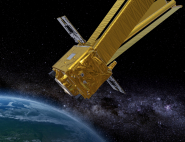Torsion pendulum
VERTICAL PENDULUM VERSUS TORSION PENDULUM (1890)
The Hungarian physicist Loránd Eötvös developed a new type of pendulum which quickly supplanted the vertical pendulum.
Between 1890 and 1920, as the vertical pendulum method began to show its limits, an innovation allowed scientists to go much further—the torsion pendulum. Thanks to this device, the British physicist Henry Cavendish measured the gravitational constant (G) in 1798.
To test the equivalence principle, Eötvös’ idea was to suspend two masses of different composition at both ends of a torsion balance beam. The test consists in checking that the beam turns 180° when the head of the suspending wire is turned by the same amount. Since the masses are subjected to Earth’s gravity field—which acts on the gravitational mass—and to centripetal acceleration from rotation of the Earth—which acts on the inertial mass—a difference would be recorded if the inertial and gravitational masses were not strictly equal. The absence of this difference, measured by Eötvös, validated the equivalence principle to an accuracy of 10-8.
This experiment aims to highlight compensation of the inertial and gravitational forces on motionless masses. Because of the measurement accuracy, experimental noises are at the same level as fundamental physics fluctuations.
These noises thus limit the experiment’s precision in later versions of the torsion balance.
![]()
Torsion balance invented by Eötvös.
It also was used to measure gravity field gradients.

